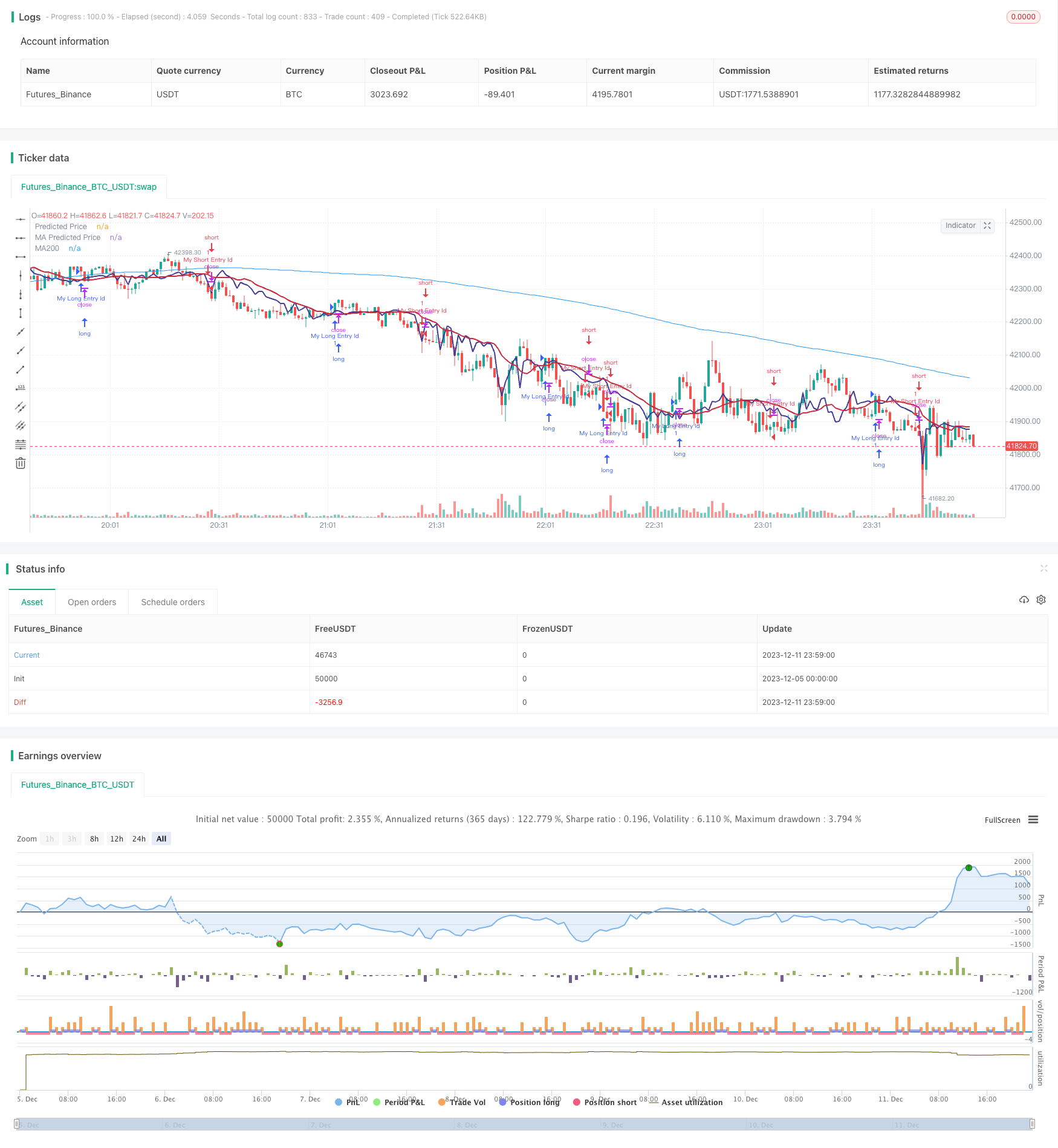Estratégia de reversão de tendência ideológica dinâmica

Visão geral
A estratégia de reversão de tendência de ideologia dinâmica usa a regressão linear para prever o preço e, em combinação com a ideologia que forma a média móvel, gera sinais de negociação. Produz um sinal de compra quando o preço previsto atravessa a média móvel de baixo para cima; Produz um sinal de venda quando o preço previsto atravessa a média móvel de cima para baixo, para capturar a reversão de tendência.
Princípio da estratégia
- Regressão linear do preço das ações calculado com base no volume de transações, obtendo o valor previsto do preço
- Calculando a média móvel em diferentes condições
- Quando o preço previsto atravessa a média móvel de baixo para cima, gera um sinal de compra
- Quando o preço previsto atravessa a média móvel de cima para baixo, gera um sinal de venda
- O indicador MACD e o tempo de reversão da tendência
Os sinais acima são combinados com vários tipos de confirmação, evitando falsas rupturas, o que aumenta a precisão do sinal.
Análise de vantagens
- Utilização de regressão linear para melhorar a precisão do sinal de previsão de tendências de preços
- A combinação de média móvel com a ideologia para capturar a reversão da tendência
- Regressão linear com base no volume de transações é mais econômica
- Combinação de indicadores como MACD para a confirmação múltipla, reduzindo os falsos sinais
Análise de Riscos
- A regressão linear pode ter um grande impacto nos resultados.
- A configuração da média móvel também afeta a qualidade do sinal
- O risco de falsos sinais, apesar do mecanismo de confirmação
- O código pode ser ainda mais otimizado para reduzir o número de transações e aumentar a taxa de lucro
Direção de otimização
- Parâmetros de otimização de regressão linear e média móvel
- Aumentar as condições de confirmação e reduzir a taxa de falsidade
- Combinação de mais fatores para avaliar a inversão da qualidade da tendência
- Optimizar a estratégia de stop loss e reduzir o risco de transações individuais
Resumir
A estratégia de reversão de tendência da ideologia dinâmica integra a previsão de regressão linear e a formação de médias móveis para capturar o momento da reversão de tendência. Comparado a um único indicador, a estratégia tem maior confiabilidade. Ao mesmo tempo, a estratégia pode melhorar ainda mais a qualidade do sinal e os níveis de lucro por meio de ajustes de parâmetros e otimização de condições de confirmação.
/*backtest
start: 2023-12-05 00:00:00
end: 2023-12-12 00:00:00
period: 1m
basePeriod: 1m
exchanges: [{"eid":"Futures_Binance","currency":"BTC_USDT"}]
*/
// This source code is subject to the terms of the Mozilla Public License 2.0 at https://mozilla.org/MPL/2.0/
// © stocktechbot
//@version=5
strategy("Linear Cross", overlay=true, margin_long=100, margin_short=0)
//Linear Regression
vol = volume
// Function to calculate linear regression
linregs(y, x, len) =>
ybar = math.sum(y, len)/len
xbar = math.sum(x, len)/len
b = math.sum((x - xbar)*(y - ybar),len)/math.sum((x - xbar)*(x - xbar),len)
a = ybar - b*xbar
[a, b]
// Historical stock price data
price = close
// Length of linear regression
len = input(defval = 21, title = 'Strategy Length')
linearlen=input(defval = 9, title = 'Linear Lookback')
[a, b] = linregs(price, vol, len)
// Calculate linear regression for stock price based on volume
//eps = request.earnings(syminfo.ticker, earnings.actual)
//MA For double confirmation
out = ta.sma(close, 200)
outf = ta.sma(close, 50)
outn = ta.sma(close, 90)
outt = ta.sma(close, 21)
outthree = ta.sma(close, 9)
// Predicted stock price based on volume
predicted_price = a + b*vol
// Check if predicted price is between open and close
is_between = open < predicted_price and predicted_price < close
//MACD
//[macdLine, signalLine, histLine] = ta.macd(close, 12, 26, 9)
// Plot predicted stock price
plot(predicted_price, color=color.rgb(65, 59, 150), linewidth=2, title="Predicted Price")
plot(ta.sma(predicted_price,linearlen), color=color.rgb(199, 43, 64), linewidth=2, title="MA Predicted Price")
//offset = input.int(title="Offset", defval=0, minval=-500, maxval=500)
plot(out, color=color.blue, title="MA200")
[macdLine, signalLine, histLine] = ta.macd(predicted_price, 12, 26, 9)
//BUY Signal
longCondition=false
mafentry =ta.sma(close, 50) > ta.sma(close, 90)
//matentry = ta.sma(close, 21) > ta.sma(close, 50)
matwohun = close > ta.sma(close, 200)
twohunraise = ta.rising(out, 2)
twentyrise = ta.rising(outt, 2)
macdrise = ta.rising(macdLine,2)
macdlong = ta.crossover(predicted_price, ta.wma(predicted_price,linearlen)) and (signalLine < macdLine)
if macdlong and macdrise
longCondition := true
if (longCondition)
strategy.entry("My Long Entry Id", strategy.long)
//Sell Signal
lastEntryPrice = strategy.opentrades.entry_price(strategy.opentrades - 1)
daysSinceEntry = len
daysSinceEntry := int((time - strategy.opentrades.entry_time(strategy.opentrades - 1)) / (24 * 60 * 60 * 1000))
percentageChange = (close - lastEntryPrice) / lastEntryPrice * 100
//trailChange = (ta.highest(close,daysSinceEntry) - close) / close * 100
//label.new(bar_index, high, color=color.black, textcolor=color.white,text=str.tostring(int(trailChange)))
shortCondition=false
mafexit =ta.sma(close, 50) < ta.sma(close, 90)
matexit = ta.sma(close, 21) < ta.sma(close, 50)
matwohund = close < ta.sma(close, 200)
twohunfall = ta.falling(out, 3)
twentyfall = ta.falling(outt, 2)
shortmafall = ta.falling(outthree, 1)
macdfall = ta.falling(macdLine,1)
macdsell = macdLine < signalLine
if macdfall and macdsell and (macdLine < signalLine) and ta.falling(low,2)
shortCondition := true
if (shortCondition)
strategy.entry("My Short Entry Id", strategy.short)